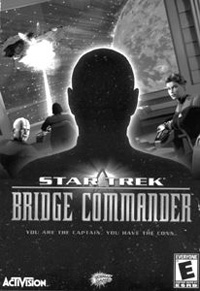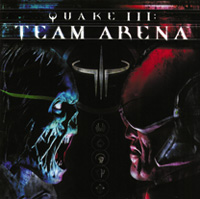 Star Trek Bridge Commander
Star Trek Bridge Commander
(Activision for PC)
By Eric Johnson
If Darth Vader, Cthulhu, and Captain Kirk had a fight to see who was king shit of the known universe, I’d have some trouble predicting the winner, but I sure as hell can tell you who would survive! Provided he had his ship and, of course, Mr. Spock to help him, the wise and mighty James T. Kirk would definitely live to see another day. Captain Kirk has strength of character, one of the most potent and least mentioned forces in this universe. That aside, when you get down to brass tacks and forget the individual episodes, the most outstanding element of the Star Trek television dynasty is the quality of actors they manage to convince to don the Captain’s suit. Patrick Stuart and Avery Brooks are, on their own, excellent actors, but once you throw William Shatner into the mix, you have every Shakespeare play covered as well as an unbeatable documentary narrator trifecta. Star Trek Bridge Commander is a valiant attempt to produce a Star Trek ship command simulator that lets you interact with a virtual bridge crew from the captain’s chair. Ironically, this awe-inspiring battle simulator manages to faithfully reproduce combat between massive starships, but offers fans little to no opportunity for the kind of strong-jawed character development that worked far better than firepower to resolve conflict in the Star Trek TV shows.
As pop culture phenomenon and pariah, most people are familiar with the bridge on a Star Trek spacecraft. It’s shaped like a circular living room with a giant viewscreen on one wall and big cheese command chair at the center. Computer consoles radiate out from the big kahuna chair, manned by top-ranking specialists for each ship function. Orders are dictated to individuals in command of weapons systems, helm navigation, science, engineering, and so on. It’s similar to the way a modern submarine works. Indeed, combat in the Star Trek universe has more in common with large vessel naval engagements than the hyperkinetic dogfights seen in Star Wars movies.
Bridge Commander can be played from a first-person perspective with your ass glued to the captain’s chair, or from a third-person external perspective. The interface is well-designed, keeping the learning curve to a minimum, but sacrifices a wide variety of ship functions. No beaming, no bluffing, quite a few of the functions associated with the shows are absent here. As a result, you can install the game and get your feet wet within a few minutes, but it also relegates the Enterprise clones you control to acting primarily as ships of war.
Extremely potent ships of war! The programmers of Bridge Commander can securely hold one bragging right to their breast. Their game has some of the most intense and awe-inspiring combat seen in a space simulator in the past few years. As I said before, starship battles in the Star Trek universe resemble naval engagements and involve a lot of tacking to bring loaded guns to bear on your opponent’s vulnerable side while denying them a clear shot of your weak points. Fights are drawn-out showdowns that force you to focus on resources and tactics rather than a test of who has the best reflexes. Targeting subsystems is easy and essential for victory, as a vessel without guns can be destroyed at your leisure, but a damaged warp core can destroy a ship long before it has sustained substantial damage. You can delegate responsibility for maneuvering, shooting, energy management and repairs to your crew, or just do it yourself. Confrontations take place in three-dimensional space as Bridge Commander breaks with Star Trek convention with full freedom of movement, without ships always meeting face-to-face. As contrived as these battles may sound, the control scheme is super-simplified and closer to those used in first-person shooters than in space simulators. Access to non-federation ships, including popular Romulan and Klingon designs, can be accessed through Quick Battle mode. These vessels have vastly different weapons and capabilities, and are a real blast to use. A major weakness of Quick Battle mode is its inability to randomize elements, so you always know who you’re fighting and how many of them there will be.
The single-player campaign unfolds much like a very, very long two-part episode and features plenty of knock-down, drag-out fights, encounters with alien races, and a good deal of scientific investigation. Unfortunately, since the story takes place within the same time frame as The Next Generation series, it’s saturated with Draconian political intrigue and references that require pre-existing knowledge of the state of things in the Star Trek universe. I would have expected a more independent, character-focused storyline from veteran author, D.C. Fontana, author of more than ten percent of the original episodes. Fontana was a specialist in character development and her emotionally-charged teleplays often involved meditations on obsession, love, obligation, and corruption.
Ironically, the crew you interact with is not engaging or charismatic in any way and Fontana’s talents are wasted on their cardboard personalities. They also have an annoying tendency to dictate your next action for you. In effect, the crew tells you what to tell them to do. This often makes you seem like more of a middle manager than anything else. So the strong Captain archetypes that make the television shows entertaining are completely absent, an ironic failure for an otherwise exceptional game.
(www.activision.com)



